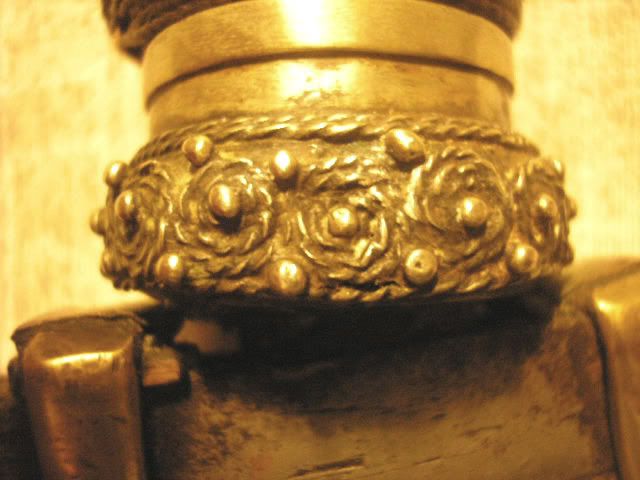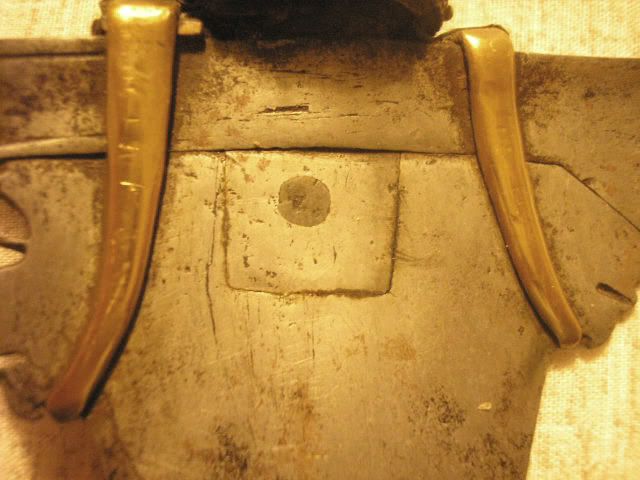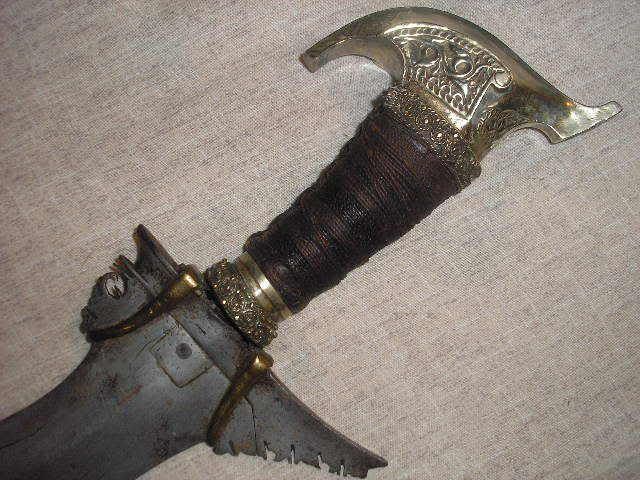
 |
|
|
#1 |
|
Member
Join Date: Dec 2004
Posts: 1,021
|
I noticed that this Kris has copper dots inset on the top part of the blade, the dots are on both sides of the sword.
Do you Forumites think that these were just place randomly or do they have any talismanic values. Any ideas |
|
|

|
|
|
#2 |
|
Member
Join Date: Jun 2008
Location: The Sharp end
Posts: 2,928
|
Interesting blade. Are they buddhists? Do the star designs represent the eightfold path?
|
|
|

|
|
|
#3 |
|
Keris forum moderator
Join Date: Aug 2006
Location: Nova Scotia
Posts: 7,250
|
I would say that given the other talismanic signs that there is probably similar purpose behind the copper dots.
The number 8 certainly does seem to have some significance here, but i doubt it has a Buddhist connection. However, i couldn't begin to guess at it's actual meaning. Very interesting blade. 
|
|
|

|
|
|
#4 |
|
Member
Join Date: Jun 2007
Location: Detroit (New Mayapan)
Posts: 96
|
I read once, in a story which took place in the Philippines, that warriors would drill holes into their kamplians and fill them with brass for every enemy they killed with that blade.
Truth? |
|
|

|
|
|
#5 |
|
EAAF Staff
Join Date: Dec 2004
Location: Louisville, KY
Posts: 7,346
|
Nice piece, especially love the talismans on the blade. Dots - yes purposeful, but meaning - ?
 Holes for slain - not enough evidence one way or the other.  Also looks Maguindanao, and I love the unusual baka-baka clamp of silver. |
|
|

|
|
|
#6 | |
|
Member
Join Date: Apr 2005
Posts: 3,255
|
Hello Albert,
Congrats, that's a very nice piece again! Quote:
Regards, Kai |
|
|
|

|
|
|
#7 |
|
EAAF Staff
Join Date: Dec 2004
Location: Louisville, KY
Posts: 7,346
|
I agree with Kai that the dots are talismanic. I wonder what the meaning could be?
 I've seen them before on kris. My own Maguindanao kris whose avatar I use has 4 silver dots, but have no idea why other than talismanic. Must be something in adat or Muslim folklore...... I've seen them before on kris. My own Maguindanao kris whose avatar I use has 4 silver dots, but have no idea why other than talismanic. Must be something in adat or Muslim folklore...... 
|
|
|

|
|
|
#8 |
|
Member
Join Date: Dec 2004
Location: Sweden
Posts: 1,637
|
Interesting piece, congratulations!
I also agree that they must have some meaning, even if we probably never really will know what. Here are two suggestions that maybe(!) could be the case: - Magic; to counter an enemy who has powers not to be hurt by steel by adding another metal in the blade. - Symbolic leverage; by including 4 higher powers in the blade they will assist the owner in the fight. I don't know which 4 powers but the most common ones are: the 4 archangels, the 4 rulers of the corners of the earth, the 4 elements, the 4 friends of the Prophet etc. Just ideas, but based on ethnographic information collected in the same cultural area. Michael |
|
|

|
|
|
#9 |
|
Member
Join Date: Jun 2008
Location: The Sharp end
Posts: 2,928
|
Lovely sword by the way Kino,
Are there definately only the four dots? No others further down the blade? |
|
|

|
|
|
#10 |
|
Member
Join Date: Dec 2004
Posts: 1,021
|
A lot of good theories. Thanks.
Atlantia, No not Buddhist, the Moro's are Muslims. There are only four copper dots on each side of the blade. Battara- Upon closer inspection the clamp seems to be made of copper that was covered in silver. I have seen suassa over silver, this is my first encounter with silver over copper. Kai- No hairline crack inline with the dots. Although there is evidence of a repair to the tang. VVV- I can't invalidate your theory, anything is possible. Does the dots have anything to do with the tang repair? Cato said that the Jin is released if the blade is separated from the ganya. I wonder if the dots were placed on the blade prior to doing the repair, to prevent the Jin from escaping. Which came first the tang repair or the copper dots??? |
|
|

|
|
|
#11 |
|
EAAF Staff
Join Date: Dec 2004
Location: Louisville, KY
Posts: 7,346
|
Good point Kino. Did not see the repair. Also, I see the dots closer now and they are in the form of an okir moon according to Saber and Orellana (circles symbolize the moon). Perhaps the power of 4 moons rising?
Maguindanao and Maranao piece often have a base metal covered by a top layer of a precious metal. I would say Maguindanao in this case. Rare to have this on a baka-baka and it being filigree at that. |
|
|

|
|
|
#12 |
|
Member
Join Date: Feb 2005
Location: Chicago area
Posts: 327
|
Very cool sword. How many dots total, can you point them all out? I'll throw in my 2 cents of speculation.
The fellow that owned this was very superstitious, so some of the meaning may specific, as to him as an individual. Perhaps he was of some religious status. Seeing as the first dot is on the gangya & is as close as you can get to holding the sword, he may have felt he was sending his inner power down into the blade. The first 4 dots certainly look as a continuation of his arm right to the center of the blade. That "repair" is interesting too. I have a blade that was clearly damaged & the tang was replaced. But I have also seen a high % of talismanic blades with what appears to be tang replacements. Could this blade be made this way deliberately? Some of the work looks like it was sawed/filed in a straight line/box; while some (like yours) are rather uneven (made in the forging process?). The tang being made of some metal of spiritual value (old sword, etc) & being added to the new sword; an old Jin, you might say? Last edited by Rick; 3rd September 2008 at 09:26 PM. |
|
|

|
|
|
#13 |
|
Member
Join Date: Dec 2004
Location: What is still UK
Posts: 5,925
|
Again we see this so called hilt repair. I am not out to start a fight but lets look at this. We see this sort of thing so often. The blades are not damaged. What sort of blow would break such renouned weapons at the hilt? leaving the blade in normal condition. I have to ask again are these swords really that crap or is this some local form of construction? To me it is just getting a little silly seeing this again and again with the same repair idea. We do not see this with other weapon world wide?
|
|
|

|
|
|
#14 | |
|
Vikingsword Staff
Join Date: Nov 2004
Posts: 6,376
|
Quote:
Perhaps this was so with the Moro peoples ..  People have said that the power of a keris resides in the tang, or pesi; so you might use the pesi of the powerful kris to enhance the power of the new sword .  Also, if this is the case why not just use the powerful metal in the forging process rather than go through the difficult process of adding it later resulting in weakening the overall structure of the sword ?  Having said that; I still think that these could also be legitimate repairs to weapons destroyed by government patrols . What would it take to bust off the tang ? Hammer and a cold chisel . You can't use a sword without a handle and you can't carry off all the confiscated stuff on patrol . Bill, I hope I didn't foul up your post.  I hit edit instead of quote .  
Last edited by Rick; 3rd September 2008 at 09:57 PM. Reason: Finally got it all in . |
|
|
|

|
|
|
#15 |
|
Member
Join Date: Dec 2004
Location: What is still UK
Posts: 5,925
|
Breaking rebel or other named fighters weapons like this would seem unique to the PI. I cannot say I have seen such actions by British empire captured insurgents weapons. Barongs do not seem to be damaged? or other sword like weapons.
|
|
|

|
|
|
#16 |
|
Member
Join Date: Dec 2004
Location: Sweden
Posts: 1,637
|
Interesting theory about adding old metal in the new kris.
I forgot before to mention that the motifs below the copper dots - the cross, the eight-petalled rosette and the double-cross - are all traditional "Folk Islam"- talismanic symbols (based on the number 5 [including the center]) to divert the effect of an opponent's evil eye. The principle is, similar to the old idea about cross-roads, to "disperse the evil energy issuing from the eye to all the quarters of the wind in order to prevent it from injuring the person or object looked at." [Westermarck, Pagan Survivals in Mohammedan Civilisation]. Michael Last edited by VVV; 3rd September 2008 at 10:07 PM. |
|
|

|
|
|
#17 | |
|
Vikingsword Staff
Join Date: Nov 2004
Posts: 6,376
|
Quote:
What to do with the weapons ?  Perhaps there was a psychological motive too; destroying a mans kris, his pride perhaps ? So . The kris is fitted with a new tang along with some talismanic symbols to protect its new integrity . |
|
|
|

|
|
|
#18 |
|
Member
Join Date: Dec 2004
Location: What is still UK
Posts: 5,925
|
Rick, the last thing I want is to discuss antique counter insurgency warfare. Saying that and you mentioned foot patrols first, what about the Naga campains. On foot and largely ignored at the time. Very brave people. All this does not help the with phenomenon we see with the hilt repiar syndrome.
|
|
|

|
|
|
#19 |
|
Vikingsword Staff
Join Date: Nov 2004
Posts: 6,376
|
Aren't we trying to figure out why it was done ?
  I'm not particularly interested in discussing said subject either . Most of these krisses came out of The Morolands during that time in history . I am not familiar with the Naga Campaigns Tim . 
Last edited by Rick; 3rd September 2008 at 11:21 PM. |
|
|

|
|
|
#20 | |
|
Member
Join Date: Apr 2005
Posts: 3,255
|
Hello Tim,
Thanks for thinking outside the box! I have no stake in this discussion but for the fun of it let me play the devil's advocate...  Quote:
While we've seen quite a few kris posted with such a repair/feature, this is still a minority (just guessing: less than 5% of surviving pre-20th century kris). Lateral stress does happen and isn't good for any sword. A bend sword can still be used and straightened out later; only a survivor will be able to comission a tang repair though. Of course, blades with fatal damages (major cracks, etc.) won't usually end up getting repaired. Often the repair/feature has been done with great skill - sometimes so good that people whose knowledge I respect a lot tend to think that it must be an original feature rather than a repair. However, there are sure examples of great repair jobs on blades from several cultures which attest to the skill of experienced bladesmiths of old. For example, Bill has a Jian where pitting has been meticulously repaired by tiny rectangular (mild?) steel inlays and the antique repair job was more expensive than the fine blade! Obviously, other factors contribute to owners' decisions for having a blade repaired. Regards, Kai |
|
|
|

|
|
|
#21 | |||
|
Member
Join Date: Apr 2005
Posts: 3,255
|
Hello Rick,
Quote:
Quote:
Quote:
Regards, Kai |
|||
|
|

|
|
|
#22 |
|
Vikingsword Staff
Join Date: Nov 2004
Posts: 6,376
|
Hello Kai,
Thanks for correcting my assumptions .  I really don't want to emphasise any war in particular . The culture has been in conflict with outsiders since the days of Magellan .  What is your opinion on this tang phenomenon ?  Esoteric or functional ? |
|
|

|
|
|
#23 | |||
|
Member
Join Date: Apr 2005
Posts: 3,255
|
Hello Albert,
Quote:
Quote:
Quote:
Regards, Kai |
|||
|
|

|
|
|
#24 | |
|
Member
Join Date: Apr 2005
Posts: 3,255
|
Hello Rick,
Quote:
It would be great to collect more data on these constructions. I'd ask anybody removing the hilt of a kris to take close-ups and measurements of the tang and also pay special attention to modifications done to the gangya. Thanks in advance! Regards, Kai |
|
|
|

|
|
|
#25 |
|
Member
Join Date: Dec 2004
Posts: 1,021
|
The other side.
|
|
|

|
|
|
#26 |
|
Member
Join Date: Dec 2004
Location: What is still UK
Posts: 5,925
|
Great fun. I know weapons do get repaired. I have done so myself quite recently
 . No seriously I still feel very unsure about so many repairs in the same spot on the same sword form from one location, with other weapons from the same location, where said to be purposely damaged [or not] are undamaged. They are not rubbish weapons we know that. We could all post pictures of this feature? . No seriously I still feel very unsure about so many repairs in the same spot on the same sword form from one location, with other weapons from the same location, where said to be purposely damaged [or not] are undamaged. They are not rubbish weapons we know that. We could all post pictures of this feature?It would also mean thousands of fallen fighters weapons left broken on the ground simply to be picked up again, then repiared just to be captured again this time not damaged for a second time.  Some how we might make sense of it all. Some how we might make sense of it all.
|
|
|

|
|
|
#27 | |
|
Member
Join Date: Dec 2004
Location: Witness Protection Program
Posts: 1,730
|
very interesting thread...
Quote:
sorry about the yellow tint. bad lighting, lol    and another similar aspect is the so called hilt repair   tim does bring up some interesting points. |
|
|
|

|
|
|
#28 |
|
Member
Join Date: Feb 2005
Location: Chicago area
Posts: 327
|
another thought on this. Dead man's sword. Captured or a fallen fellow warrior, the Jen would have failed the previous owner if killed in battle. Lack of metal/time & no lack of enemies could necessitate re-use.
I worked in a craft job that had a occasional death. The deceased's tools were known as "dead mans tools" & always thrown in the dumpster. I can only imagine what may have been thought about a sword with a Jen that failed. Perhaps this is why we see the talismanic markings many of the "tang repaired" blades. It may not be tang related at all but tossing out a bad Jen. |
|
|

|
|
|
#29 |
|
Member
Join Date: Dec 2004
Location: What is still UK
Posts: 5,925
|
Strange as it seems that sounds better to me. I feel there must be some cultural reason for this construction. The more you think about the many thousands of these examples being broken in the field then repiared and recaptured, it sarts to fall apart. To me anyway.

|
|
|

|
|
|
#30 | |
|
Member
Join Date: Apr 2005
Posts: 3,255
|
Hello Bill,
Quote:
Regards, Kai |
|
|
|

|
 |
| Thread Tools | Search this Thread |
| Display Modes | |
|
|